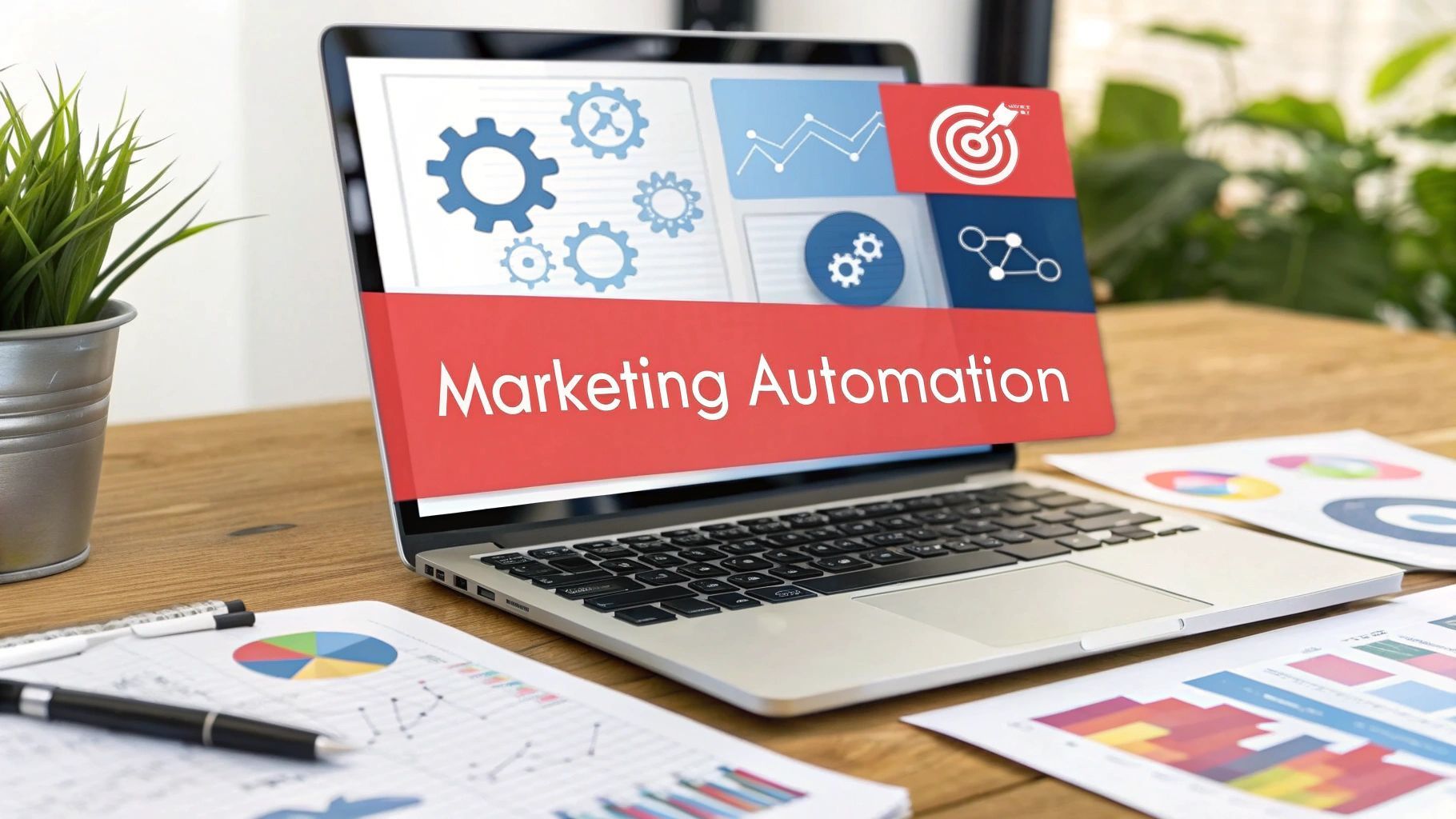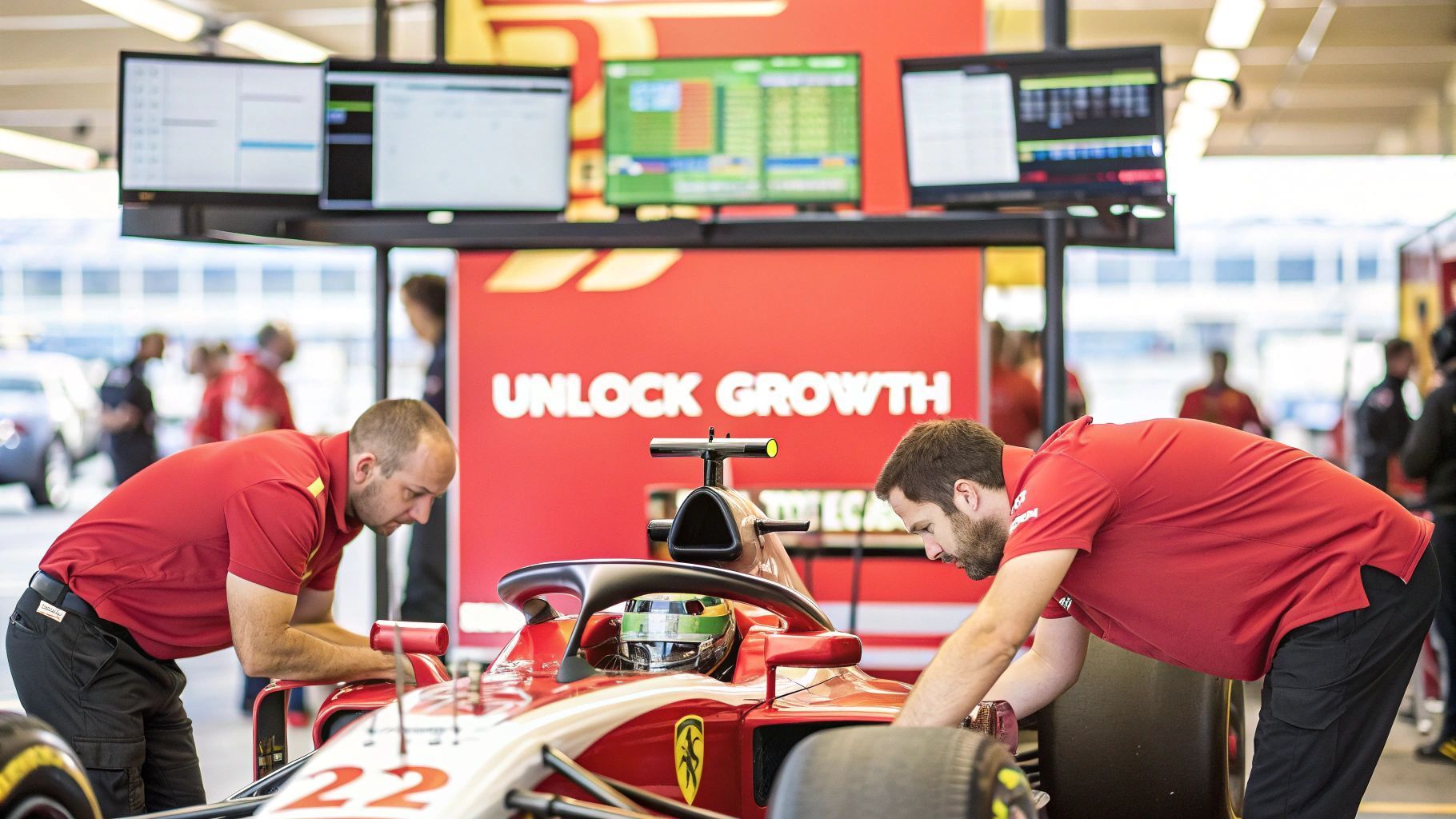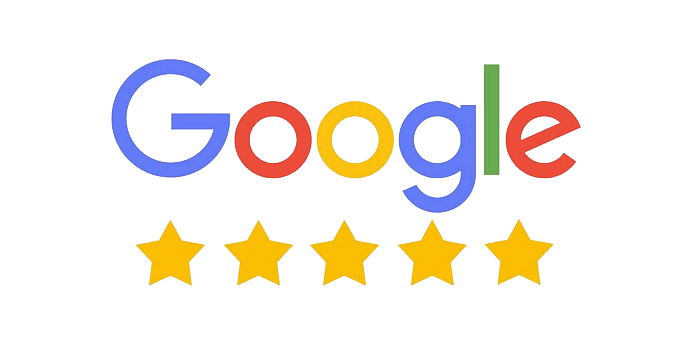What Is Programmatic Advertising Explained
Programmatic advertising is simply the use of automated technology for buying and selling digital ad space. Think of it as a high-speed stock exchange but for online adverts.
Instead of people manually negotiating deals, software handles the entire transaction in the milliseconds it takes for a webpage to load.
Understanding Programmatic Advertising in Plain English
Let's break it down. Imagine you're trying to sell a product. The old way of advertising was like renting a specific billboard on a busy motorway, hoping the right people would drive past. You'd negotiate a price, sign a contract and your ad would be displayed for a month, regardless of who actually saw it. This whole process was slow, clunky and often hit-and-miss.
Programmatic advertising completely flips this on its head.
It’s more like having a super-fast personal assistant standing by that same billboard. Every single time a car drives past, your assistant instantly figures out if the driver is your ideal customer. If they are, your ad is placed on the billboard just for that split second. If not, the space goes to another advertiser whose customer is in the next car.
This instantaneous auction happens billions of times a day across the internet. The entire system is built on data and algorithms, making sure that advertisers reach the people who matter most while publishers get the best possible price for their ad space.
For a deeper dive into the fundamental concepts, this guide on What is Programmatic Advertising is a great resource.
The Automated Shift in Ad Buying
This move towards automation has become the new normal for digital advertising. The infographic below really highlights the core difference between the old manual process and the new, tech-driven one.

The main thing to take away is the shift from slow human negotiation to smart, technological efficiency. It’s what allows for faster, sharper and far more precise ad placements.
A Dominant Force in the UK Market
This efficiency has fuelled incredible growth, especially here in the UK. Programmatic is no longer just a trend; it's the dominant force in digital advertising.
Recent industry analysis projects that programmatic spending in the UK will soon hit £8.8 billion . This figure really underlines how much advertisers now rely on these automated, data-driven methods to get their message out.
How a Programmatic Ad Auction Really Works
That targeted advert you see on a webpage? It didn't just appear by chance. The whole process, from you landing on the page to the ad loading, happens in the time it takes you to blink. This incredibly fast, automated auction is known as Real-Time Bidding (RTB) and it's the engine that powers most programmatic advertising.
It all kicks off the moment you arrive on a website. Let's say you've just clicked on an article on a popular UK news site. That simple action triggers a complex but lightning-fast chain of events behind the scenes, all designed to fill the empty ad space with the most relevant advert possible.
The Bidding Process Step-by-Step
First, the publisher's website sends out a signal to its Supply-Side Platform (SSP). This signal contains details about the available ad space and, crucially, some anonymised data about you—things like your browsing history, location and what type of device you're using. The SSP then passes this information over to an ad exchange.
Think of the ad exchange as a digital marketplace. It receives the ad request and shows it to multiple Demand-Side Platforms (DSPs), which are all representing different advertisers. Each DSP instantly analyses your data to figure out if this particular ad impression is a good fit for their advertiser's campaign.
If you fit an advertiser's target audience—maybe you're a known car enthusiast browsing a motoring blog—their DSP will place a bid for that ad space. This entire analysis and bidding frenzy happens across countless DSPs at the same time, all in a tiny fraction of a second.
The whole auction, from the initial ad request to the winning ad being served, typically takes less than 100 milliseconds . That's quicker than the human eye can even process an image.
The ad exchange then looks at all the bids that came flooding in and picks the highest one. That advertiser is the winner. The winning ad creative is then instantly sent back through the system—from the DSP, through the ad exchange and SSP and finally to the publisher's website. The advert then pops up on your screen as the page finishes loading.
Visualising the Auction Flow
This whole back-and-forth can be tricky to picture but this diagram shows the rapid interaction between all the key platforms during a real-time bidding auction.
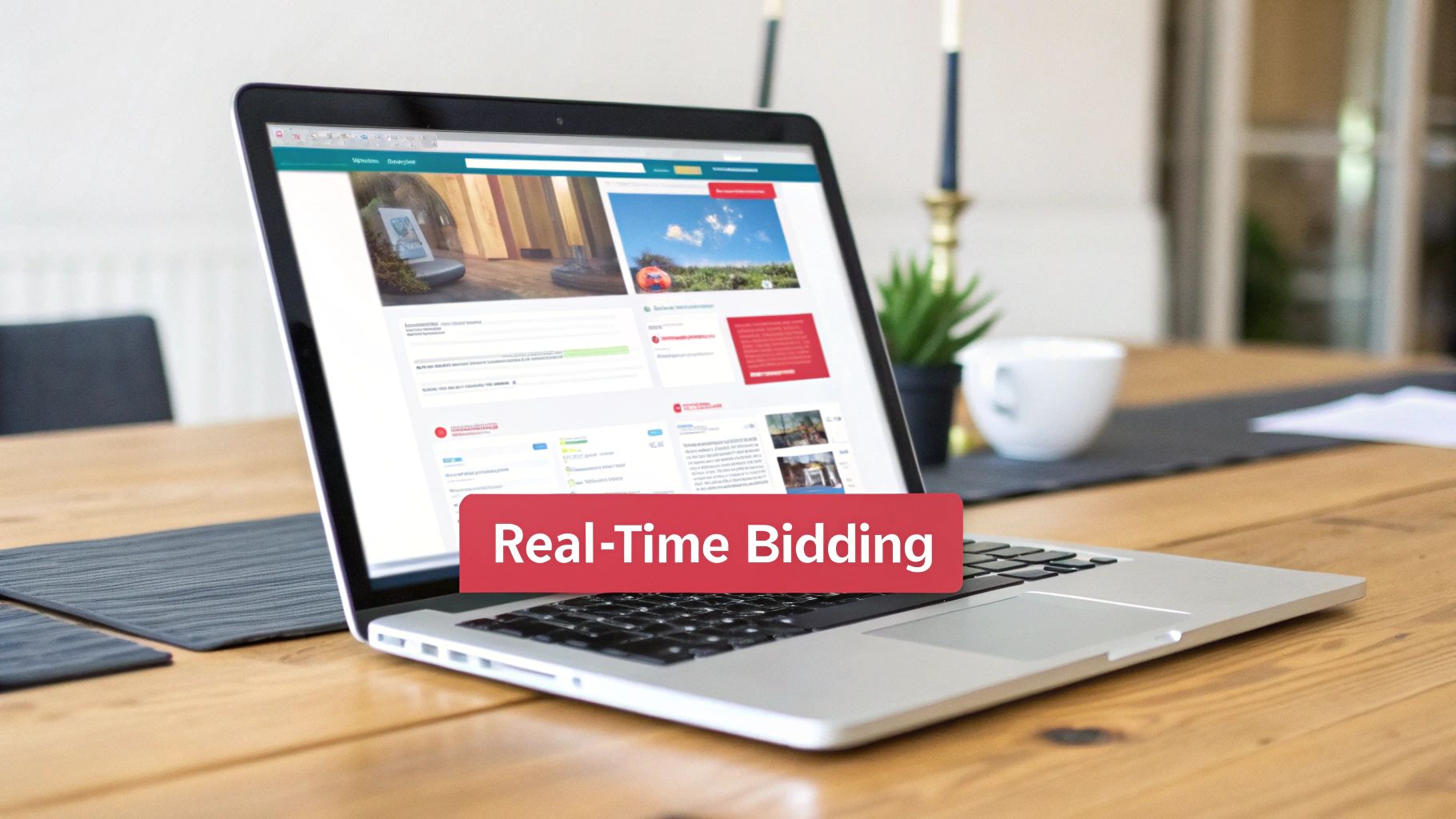
As you can see, it all starts with your browser. Your visit initiates a request that flows through the publisher's site, their SSP and the ad exchange to reach multiple advertiser DSPs who all bid for the chance to show you their ad.
This automated system ensures every single ad impression is sold to the highest bidder whose target audience matches the person viewing the page. For publishers, it maximises their revenue. For advertisers, it means they're paying a fair market price to reach the right people, cutting down on wasted ad spend and making the entire process remarkably efficient.
The Core Components of the Programmatic Ecosystem
To really get what programmatic advertising is, you need to know the tech that makes it all tick. The whole system hinges on several key platforms working together in a fraction of a second during an ad auction. These components are the backbone of the programmatic ecosystem, connecting advertisers who want to buy ad space with publishers who want to sell it.
Each piece of tech has a specific job and serves a different side of the market. A good way to think about it is like a stock exchange. You have tools for buyers, different tools for sellers and a central marketplace where they all meet. In our world, these are the DSPs , SSPs , Ad Exchanges and DMPs .
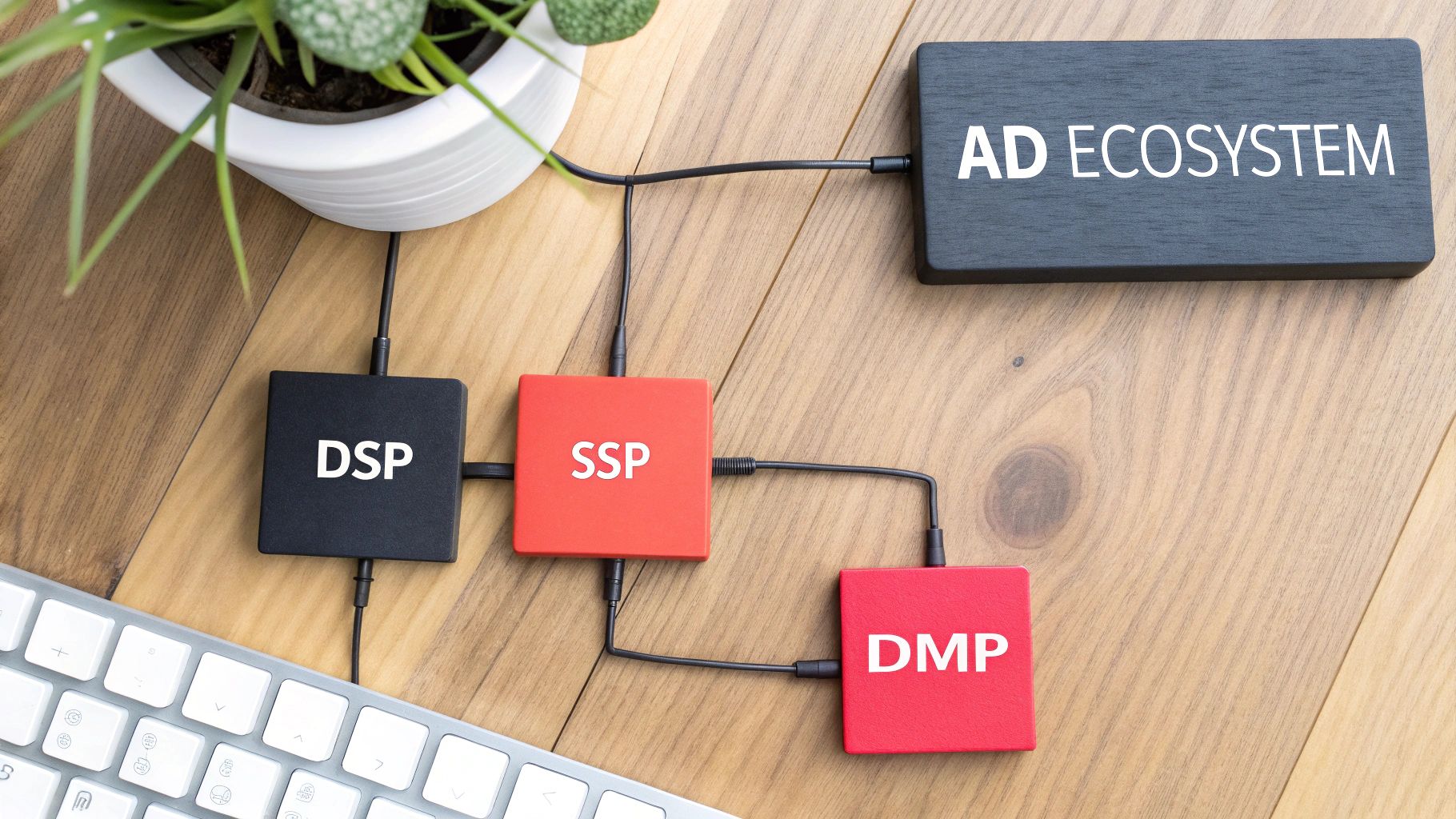
Demand-Side Platforms (DSPs)
A Demand-Side Platform (DSP) is the advertiser's toolkit. It's the software that marketing agencies and brands use to buy ad inventory from loads of different sources, all through one interface. This is where they set up campaigns, define who they want to reach and manage their spending.
When a website has an ad space available, the DSP looks at the user data and instantly decides if it's a good match for the advertiser's campaign. If the user fits the bill, the DSP places a bid in the auction. It’s firmly on the buyer’s side of the equation.
Supply-Side Platforms (SSPs)
On the flip side, a Supply-Side Platform (SSP) is what publishers—the owners of websites and apps—use to sell their ad space. An SSP lets them offer their ad inventory to a massive pool of potential buyers automatically.
The main job of an SSP is to squeeze as much revenue as possible from a publisher's ad space. It does this by connecting to multiple ad exchanges and DSPs, making sure loads of advertisers can bid on the inventory. More bidders mean higher prices. Simple. The SSP is the essential tool for the seller.
Ad Exchanges
The Ad Exchange is the neutral marketplace that connects the DSPs and SSPs. This is the trading floor where the actual buying and selling happens. Think of it as the London Stock Exchange but for digital ad slots.
The Ad Exchange is what makes real-time bidding possible. It gets the ad request from the publisher's SSP and flashes it in front of countless DSPs all at once. It then gathers all the bids, picks the highest one and declares a winner.
Data Management Platforms (DMPs)
A Data Management Platform (DMP) is the brains behind the targeting operation. It’s basically a massive data warehouse that collects, organises and activates huge sets of audience data from all sorts of places. This could be anything from demographic info to browsing habits and past purchases.
DSPs often tap into DMPs to make smarter bidding decisions. By digging into the rich data a DMP holds, an advertiser can target their campaigns with incredible accuracy, making sure their ads get in front of the right people. To dig deeper, check out our guide on harnessing the power of data-driven marketing strategies for success.
To make these roles even clearer, here's a quick breakdown of how each platform fits into the puzzle.
The Programmatic Advertising Ecosystem at a Glance
| Component | Primary User | Core Function |
|---|---|---|
| Demand-Side Platform (DSP) | Advertisers & Agencies | Buys ad inventory across multiple exchanges. |
| Supply-Side Platform (SSP) | Publishers & App Developers | Sells ad inventory to maximise revenue. |
| Ad Exchange | (Neutral Platform) | Facilitates the real-time auction between DSPs and SSPs. |
| Data Management Platform (DMP) | Advertisers & Agencies | Collects and manages audience data for precise targeting. |
Each component has a distinct role but they all have to work together seamlessly to make the magic happen in that split second.
In short: the DSP fights for the buyer, the SSP works for the seller, the Ad Exchange is the marketplace where they meet and the DMP provides the crucial data that fuels the whole transaction.
Why Are So Many UK Businesses Turning to Programmatic Advertising?
Now that we’ve got a handle on what programmatic advertising is and how it works, the natural next question is why. Why are so many UK businesses making it a core part of their marketing? The answer is simple: it delivers a powerful mix of efficiency, precision and real-time agility that traditional methods just can't compete with.
At its core, this shift is all about moving from manual, time-consuming grunt work to automated, strategic action. Instead of teams spending hours on the phone negotiating ad buys, programmatic technology does all the heavy lifting. This frees up marketers to focus on what actually matters—refining campaign strategy, digging into performance data and understanding their customers on a much deeper level.
Driving Efficiency and Precision
One of the biggest draws is the sheer efficiency of it all. Programmatic advertising automates the entire process of buying and selling ad space, transforming what was once a slow, clunky procedure into an instant transaction. That kind of speed means businesses can react to market shifts in the blink of an eye.
But it’s not just about speed; it’s about accuracy. By using rich data, businesses can reach their ideal customers with surgical precision, targeting them based on demographics, interests and online behaviour.
This data-first approach means far less money is wasted on audiences who are never going to convert. Every pound is invested more intelligently, aimed at connecting with people who are genuinely interested in what you have to offer.
This level of precision is a major reason why the UK is a market leader. The UK’s programmatic ad market isn't just the largest in Europe; it’s miles ahead of its closest rivals. Forecasts show UK programmatic ad spend hitting around £18.5 billion —nearly double the combined spend of Germany and France. You can explore more of these programmatic ad spend forecasts on eMarketer.com.
Real-Time Optimisation and Transparency
Another game-changing benefit is the ability to optimise campaigns in real time. Marketers are no longer locked into a campaign for weeks or months, just hoping for the best. With programmatic, you can monitor performance as it happens and make immediate adjustments.
If an advert is underperforming, you can tweak it or pull it instantly. If a particular audience is showing great engagement, you can shift more budget its way on the fly. This agility ensures your marketing spend is always working as hard as it possibly can to hit your goals.
Finally, today’s programmatic platforms offer much greater transparency. They provide detailed insights into where your ads are being shown and how they’re performing. This helps businesses understand their return on investment with a clarity that was once unimaginable, building trust and enabling smarter decisions for every campaign that follows.
Navigating the Different Programmatic Deal Types
Programmatic advertising isn’t a one-size-fits-all game. It’s more like a spectrum, offering different ways to buy ad space that give you varying levels of control, priority and pricing. Understanding your options is the key to building a campaign that actually hits your goals, whether that’s getting your message in front of as many people as possible or securing a prime spot on a top-tier website.
These deals range from wide-open auctions that anyone can join to exclusive, private arrangements that feel a lot more like traditional ad sales. Each one has its place, giving you the flexibility to decide exactly how you want to access and buy digital ad inventory.

Open Auctions or Real-Time Bidding (RTB)
The most common way to buy programmatic ads is through the open auction , also known as Real-Time Bidding (RTB) . You can think of this as a huge public marketplace. Pretty much any advertiser can show up and bid on available ad space from a massive pool of publishers.
This approach is fantastic if your main goal is achieving huge scale and reach without breaking the bank. The highest bidder wins the ad impression, plain and simple. It's a dynamic and cost-effective way to connect with broad audiences but the trade-off is that you have less control over exactly where your ads end up.
Private Marketplace (PMP)
A Private Marketplace (PMP) is a step up in exclusivity. It's an invitation-only auction where a publisher, or a group of them, offers their premium ad inventory to a handpicked group of advertisers. This creates a much more controlled and brand-safe environment than the wild west of the open auction.
PMPs offer a great middle ground, blending the efficiency of programmatic bidding with the kind of high-quality inventory you just won’t find on the open market.
Advertisers get first dibs on better ad placements and more insight into the inventory while publishers can command higher prices from buyers they trust. It’s a win-win for anyone who puts a premium on quality and transparency.
Preferred Deals
Preferred Deals take that exclusivity even further. In this setup, an advertiser gets the very first look at a publisher's inventory at a pre-agreed fixed price. This happens before the ad space is ever offered in a PMP or the open auction.
This "first look" opportunity lets advertisers lock in predictable placements on highly desirable websites without having to fight it out in an auction. If the advertiser decides to pass on the impression, it then gets offered to everyone else. This model is perfect for brands that want to guarantee their ads will appear on specific, high-value sites.
Programmatic Guaranteed
Finally, we have Programmatic Guaranteed , which is the closest programmatic gets to old-school, direct ad sales. Here, the advertiser and publisher agree on a fixed price for a specific number of ad impressions. The whole deal is then executed automatically through programmatic platforms.
This deal type guarantees both the inventory and the price, completely removing the guesswork of auctions. It’s the go-to choice for large-scale, high-impact campaigns where securing specific, premium inventory is the absolute top priority. You get the certainty of a direct buy with the efficiency of automation.
The Future of Programmatic Advertising in a Privacy-First World
The ground is shifting under the world of digital advertising. With privacy now front and centre for both consumers and regulators, the industry is being forced to say goodbye to third-party cookies. This isn't the end for programmatic, though—it's the start of something smarter and a lot more respectful.
The biggest change is how the industry is adapting to a cookieless world. Instead of leaning on old tracking methods, advertisers are now getting creative with privacy-friendly alternatives. The focus has shifted to first-party data —information that customers share willingly—and smarter contextual targeting to keep ads relevant without creeping people out.
This isn't just about ticking compliance boxes; it’s about building trust. The future of advertising is a transparent value exchange, where brands earn the right to be relevant by respecting personal data.
Beyond the Banner Ad: New Channels on the Rise
At the same time, programmatic is breaking out of its traditional display ad container and moving into some exciting new territories. We're seeing it pop up in the channels that are becoming a bigger part of our daily lives.
- Connected TV (CTV): As more of us cut the cord and switch to streaming, programmatic is bringing its data-driven precision to the living room, allowing for laser-focused campaigns on services like Netflix and Disney+.
- Digital Audio: Think podcasts and music streaming. Programmatic audio is reaching listeners during screen-free moments, making it a powerful and intimate channel.
- Digital Out-of-Home (DOOH): Even the billboards you see on your commute are getting a programmatic upgrade. Ads can now change on the fly based on real-world triggers like the time of day, local traffic or even the weather.
AI Is Running the Show
Artificial intelligence is the engine powering this entire shift. AI and machine learning are no longer just buzzwords; they’re essential tools for fine-tuning campaigns, sharpening targeting and personalising ad creative at a scale that just wasn't possible before.
AI is completely reshaping the programmatic space, with some estimates suggesting that 80% of digital display ads will soon be touched by its influence. This allows brands to deliver campaigns that are not only more personal but also fully privacy-compliant. You can discover more insights about retail media and TV on iabuk.com.
These changes all point to a more sophisticated and intelligent future for automated advertising. If you're looking to get ahead of the curve, you can read more about the future of digital advertising trends and innovations to watch in our detailed guide.
Frequently Asked Questions About Programmatic Advertising
To wrap things up, let’s tackle some of the most common questions that pop up around programmatic advertising. This should help clear up any lingering confusion and give you a solid handle on the practical side of things.
Is Programmatic Advertising Only For Large Businesses?
Not at all. While the big brands with massive budgets are certainly all over it, programmatic is surprisingly scalable and works just as well for small and medium-sized businesses (SMEs).
The beauty of real-time bidding is its flexibility. You can start with a modest budget and see where it takes you. Unlike old-school media buys that demanded a huge upfront commitment, programmatic lets you set daily spending caps and tweak them on the fly based on what’s actually working. This makes it a genuinely cost-effective way to advertise, no matter your size.
How Is It Different From Google Ads?
This is a great question. Think of it like this: Google Ads is a type of programmatic advertising but it operates inside its own walled garden. It’s brilliant for buying ad space across Google’s own turf—like Search, YouTube and its massive network of partner websites.
But broader programmatic advertising blows the doors wide open. It gives you access to a much bigger playground of ad inventory across countless ad exchanges and publishers that exist well beyond Google’s ecosystem. We’re talking premium websites, Connected TV and digital audio platforms, giving you a far more expansive reach.
What Are The Main Challenges?
The biggest hurdles are usually its complexity, brand safety and the ever-present risk of ad fraud. Let's be honest, the programmatic world has a lot of moving parts and getting to grips with a DSP can feel like a steep learning curve. This complexity is one of the main reasons many businesses decide to work with experts when choosing a programmatic advertising agency.
On top of that, automation brings the risk of your ads showing up next to content you’d rather avoid. The good news is that modern platforms have robust brand safety tools and fraud detection filters built-in, helping you protect your reputation and make sure your budget is spent on real people, not bots.
At Superhub , we cut through the complexity of programmatic advertising and build targeted strategies that deliver real business growth. Find out how we can help you at https://www.superhub.biz.

